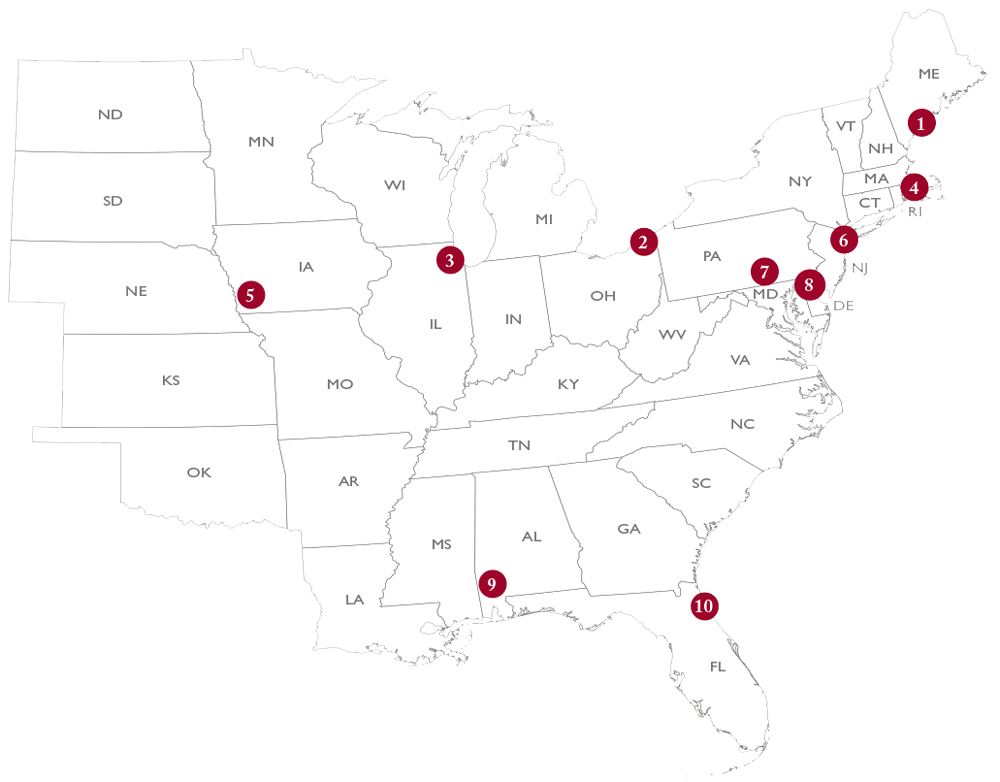1 Abyssinian Meeting House
Portland, Maine
Built in 1828, this building served as a place of worship for Black Mainers as well as a safe haven for fugitive slaves, according to a descendant of its first minister.
2 Col. William Hubbard House
Ashtabula, Ohio
Also known as “Mother Hubbard’s Cupboard,” William and Catherine Hubbard’s house was a last stop before Canada for many fugitives. A tunnel connecting the barn to Lake Erie allowed runaways to board a waiting boat and cross to Ontario.
3 Blanchard Hall
Wheaton, Illinois
An ornate building on the campus of Wheaton College hosted fugitives en route to Canada. One witness wrote in 1861 that “so strong was public sentiment that runaway slaves were perfectly safe in the college building even when no attempt was made to conceal” them.
4 Nathan and Polly Johnson House
New Bedford, Massachusetts
During Frederick Douglass’ escape from Baltimore, he stayed with Nathan and Polly Johnson. Here he decided to change his last name from Bailey to Douglass, a nod to a character in Walter Scott’s The Lady of the Lake, which Nathan was reading at the time.
5 Hitchcock House
Lewis, Iowa
Built by the abolitionist minister George B. Hitchcock in 1856, the house contains an unusual room in the basement believed to have been built to house escaped slaves, with an entrance concealed by a cupboard.
6 Plymouth Church of the Pilgrims
Brooklyn, New York
In 1854 Reverend Henry Ward Beecher, brother of Harriet Beecher Stowe, encouraged his congregation to send boxes of Sharps rifles marked bibles to Kansas to support efforts to fight pro-slavery settlers.
7 McAllister’s Mill
Gettysburg, Pennsylvania
For decades McAllister’s Mill, popularly referred to as Jimmy’s, offered safe harbor to more than two hundred escaped slaves, who sometimes hid in a chamber behind the mill’s waterwheel,
8 Abigail and Elizabeth Goodwin House
Salem, New Jersey
Abigail Goodwin, a founding member of the Female Benevolent Society, offered assistance to escaped slaves. In 1855 she wrote to the abolitionist William Still, “Would it not be well to get up a committee of women to provide clothes for fugitive females?”
9 Hal’s Kingdom
Hal’s Kingdom
In the 1820s an escaped slave named Hal hid in a swamp between the Tombigbee and Alabama Rivers, where other fugitives joined him. Local planters attempted to recapture the group, leading to a gunfight that killed Hal and many others.
10 Castillo de San Marcos
St. Augustine, Florida
In 1687 nine enslaved people fled from colonial Carolina to this fort in St. Augustine. When an English official came seeking them the following year, the Spanish governor refused to hand them over. The escape inspired others to head for Florida; in 1693 Charles II of Spain decreed “liberty to all” who reached his colonies.
